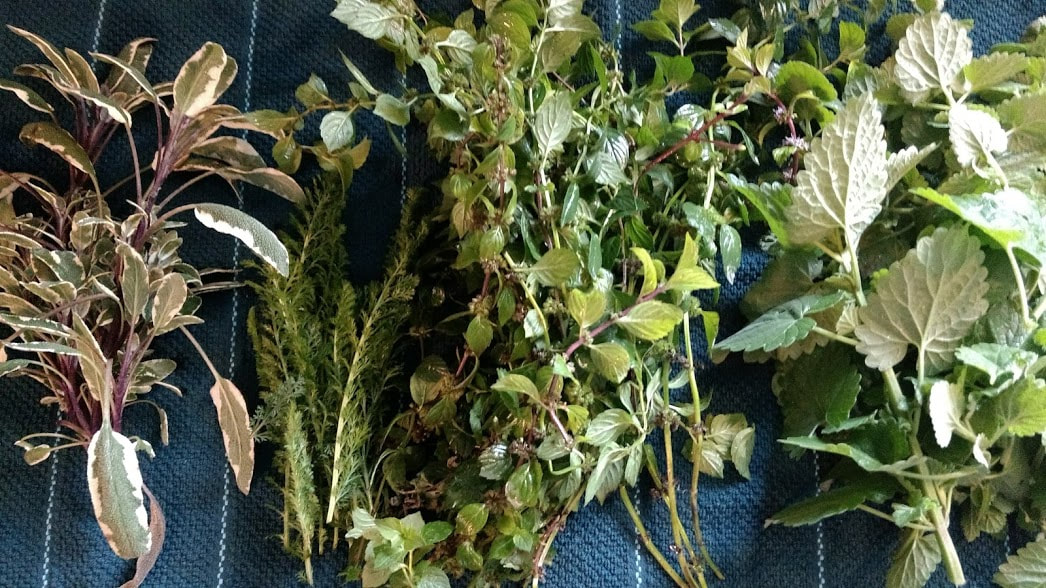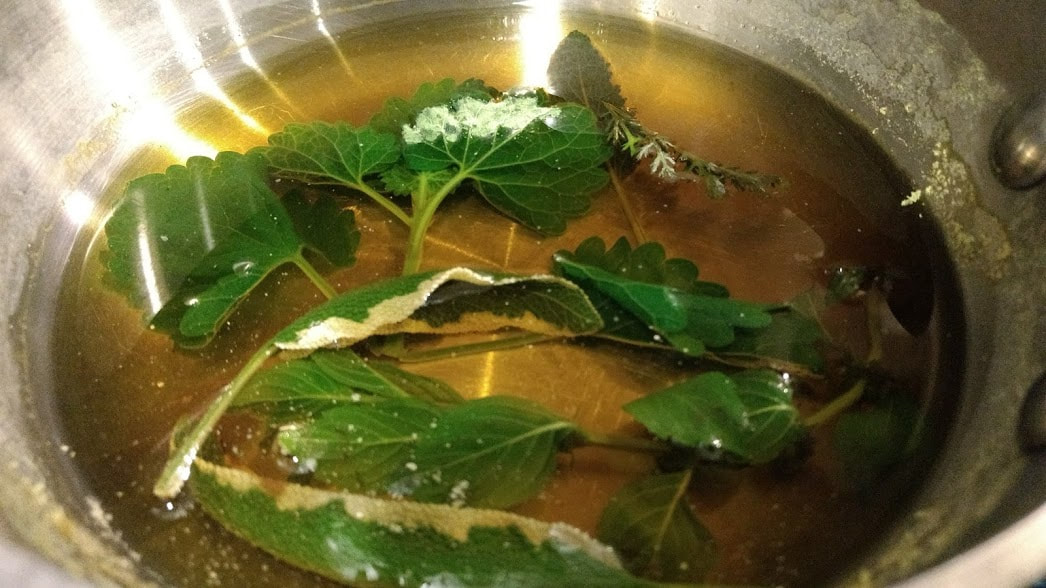
On Thanksgiving Day the smell of sage, a seasoning often used in turkey stuffing may trigger memories of family gatherings. According to Mike Castleman’s book, “The New Healing Herbs”, the history of sage used in medicine is vast –prescribed for snake bites, epilepsy, and intestinal worms and made into a poultice to bandage wounds. An English proverb, “He that would live forever/Must eat sage in May.”
With frosty nights in the air, NOW is the time to harvest your perennial herbs if you have not already done so, to preserve and dry leaves for use during the winter. The herbs in the photo above are described in order, left to right, below.
Sage (Salvia officinalis) – Dried sage leaves are an excellent remedy to have on hand for sore throats due to its anti-bacterial properties and containing astringent tannins. In Germany a “hot sage gargle” for sore throats and tonsillitis is recommended by physicians. Some writings suggest mixing sage tea with a bit of apple cider vinegar for sore throats. Sage also helps to settle indigestion. A chemical in sage, thujone, is considered potentially toxic, however the heat used to make an infusion eliminates much of the chemical making the amount recommended for medicinal purposes is minimal.
Yarrow (Achillea millefolium) – Yarrow is a versatile herb, having potential as a digestive aid, menstrual remedy and mild sedative – to containing substances that can possibly stop bleeding and offer pain relief in wounds healing, with anti-inflammatory benefits. Chamomile and yarrow tea are a synergestic tea team to help relax the smooth muscle of the digestive tract. Yarrow can do the same for the smooth muscle of the uterus, making it a useful remedy for menstrual cramps.
Chocolate Mint (Mentha peperita) – A cross between water mint and spearmint, this spreading mint plant is wonderful to have on hand for chocolate lovers who wish to curb their cravings. I have enjoyed adding this herb to my chocolate protein smoothies during the growing season for an extra burst of delicious flavor. Check out this link for more ideas on Chocolate Mint uses, such as mojitos and adding 5 chocolate mint leaves to your coffee. I am willing to bet you will want to add this to your springtime planting list!
Mint is known to aid in digestion, and has been used to treat nausea and headache.
Catnip (Nepeta cataria)– At Purely Living Wellness Catnip is the key ingredient in our homemade insect repellent. Although felines have an affinity for catnip, humans can benefit as well. Catnip is a wonderful sleep-inducer, much the same as the more well-known Valerian root. For this purpose consider combining with chamomile. When used as a tea it does not give the “kitty high” effect, and instead it calms the nervous system – consider catnip tea for a child, sweetened with a bit of raw honey. Perhaps some catnip tea would do your feline well prior to a veterinary visit… Health benefits of Catnip include anti-oxidants of Vitamins C and E. In the mint family, Catnip is a mellow version of mint minus the menthol.
Each of these plants may make lovely additions to one’s landscape, and of course, catnip grows wild here in Wisconsin so you may find it readily in ditches, along fences, hillsides, and more. Since I began foraging and learning about the health benefits of herbs my spring plant purchases are focused on one thought, “what benefit can my family reap from this plant if I am to purchase and/or plant it”.
As I typed this blog post I added to a shallow pan of water what remained on my towel after rinsing my herbs prior to hanging them to dry. This included two sprigs of chocolate mint, a large sprig of catnip, a sage leaf, and a small piece of yarrow. Once the simmering water extracted the phytochemicals I strained the leaves, pouring the hot water into my mug and added two drops of liquid stevia extract. Without the stevia I was not too keen on the taste, but once sweetened ever so slightly the tea is delicious!
Rita S.
Please note that pregnant or nursing women, nor children under age 2, should use herbals without first consulting their trusted physician.




 RSS Feed
RSS Feed
